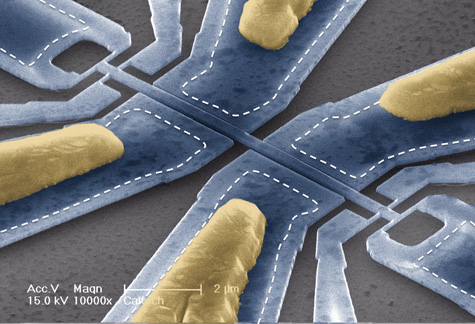New Device Can Measure the Mass of a Single Molecule
Caltech scientists have created an ultra-sensitive device that can weigh an individual molecule for the first time
/https://tf-cmsv2-smithsonianmag-media.s3.amazonaws.com/filer/20120827090043molecule-thumb.jpg)
![]()

An electron scanning micrograph of the molecule-weighing device. When a molecule lands on the bridge-like portion at the center, it vibrates at a frequency that indicates its mass. Image via Caltech/Scott Kelberg and Michael Roukes
How much do you think a molecule weighs? A molecule, which is single group of bonded atoms—the two hydrogens and one oxygen that make up H2O, for example—is almost incomprehensibly tiny. One mole of water, which is roughly 0.64 ounces, has 602,214,078,000,000,000,000,000 molecules. Molecules, in short, are really, really, really small.
Up until now, scientists could only calculate the mass of large groups of molecules, by ionizing them (giving them an electric charge) and then seeing how strongly they interacted with an electromagnetic field, a technique known as mass spectrometry. They had no way, however, of measuring the mass of a single molecule.
But yesterday scientists from Caltech announced the invention of a device that directly measures the mass of an individual molecule. As described in a paper published in the journal Nature Nanotechnology, the tiny apparatus is built around a bridge-like structure that vibrates at a specific frequency based on the mass of the molecule on top of it. By precisely tracking the vibrating frequency of the bridge, they can determine the exact mass of the molecule.
“The critical advance that we’ve made in this current work is that it now allows us to weigh molecules—one by one—as they come in,” says Michael Roukes, the principle investigator of the lab that produced the paper. “Nobody’s ever done this before.”
To the naked eye, the device is essentially invisible—the scale at the bottom of the microscope image above is two microns long, or two millionths of a meter. The vibrating bridge at its center is technically known as a nanoelectromechanical system resonator and has been under development for over a decade.
In previous work, published in 2009, the researchers showed that they could measure the mass of particles sprayed onto the apparatus but with one limitation: It wasn’t sensitive enough to measure just one molecule at a time. Because the specific location where a particle landed affected the vibrating frequency, and the scientists had no way of knowing exactly where this would be, they needed to apply several hundred identical particles in order to find an average, which revealed the mass.
The advance makes use of a new insight into the way the vibrating frequency of the bridge changes when a molecule is sprayed onto it. The vibrations occur in two modes simultaneously: The first mode is side-to-side swaying, while the second mode occurs in the form of an oscillating S-shaped wave that moves up and down the bridge. By analyzing exactly how each of these modes change when the molecule hits the device, the researchers found they could determine its position, and thus its exact mass.
In the study, the researchers demonstrated the effectiveness of the tool by measuring the mass of a molecule called immunoglobulin M, or IgM, an antibody produced by immune cells in the blood and that can exist in several different forms. By weighing each molecule, they were able to determine exactly which kind of IgM it was, hinting at potential future medical applications. A kind of cancer known as Waldenström macroglobulinemia, for instance, is reflected by a particular ratio of IgM molecules in a patient’s blood, so future instruments building on this principle could monitor blood to detect antibody imbalances indicative of cancer.
The scientists also envision this type of device as an aid to biological researchers looking into the molecular machinery inside a cell. Since the enzymes that drive a cell’s functioning are highly dependent on molecular attachments on their surface, precisely weighing proteins at various times and in different types of cells could help us better understand cellular processes.
The team even predicts that their invention could have everyday commercial applications. Environmental monitors that track nanoparticle pollution in the air, for instance, could be activated by arrays of these vibrating bridges.
Importantly, the scientists say, the device was constructed using standard semiconductor fabrication methods—the same used in common electrical circuits—so it can theoretically be scaled up to apparatuses that include hundreds or tens of thousands of the single-molecule sensors operating at once. “With the incorporation of the devices that are made by techniques for large-scale integration, we’re well on our way to creating such instruments,” says Roukes.
/https://tf-cmsv2-smithsonianmag-media.s3.amazonaws.com/accounts/headshot/joseph-stromberg-240.jpg)



/https://tf-cmsv2-smithsonianmag-media.s3.amazonaws.com/accounts/headshot/joseph-stromberg-240.jpg)